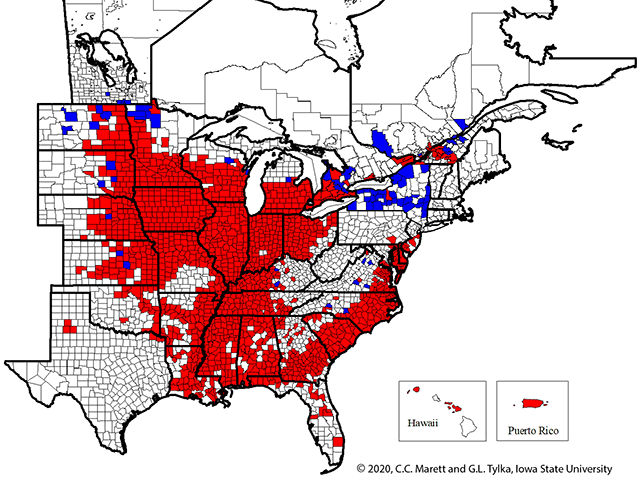Soybean Cyst Nematode Continues Move
SCN Continues to Spread Across US, Canada
DECATUR, Ill. (DTN) -- A new survey shows soybean cyst nematode (SCN) is continuing to spread across the United States and into Canada.
New areas reporting SCN infestations are indicated by the blue areas on the map accompanying this article.
SCN moved into 55 additional counties in the U.S. in 11 states during the past three years. It has also been found in 24 new counties and rural municipalities in the Canadian provinces of Manitoba, Ontario and Quebec. The new regions paint a disturbing picture since most of the major soybean growing areas are already battling the pest (see red on map).
Greg Tylka, Iowa State University nematologist and co-leader of The SCN Coalition, gathered the new data on SCN's spread by surveying plant health professionals at universities and departments of agriculture across the U.S. and Canada.
SNEAKY PEST
SCN is a sneaky adversary because despite being widely distributed and causing significant yield reductions, SCN often goes unnoticed in fields as yield losses are not always accompanied by visual symptoms. (https://apsjournals.apsnet.org/…)
SCN distribution maps help raise awareness of the pathogen. Tylka said the 2020 results reveal steady expansion. "And, the pest will almost certainly continue to spread among and within soybean-producing areas," he said.
P[L1] D[0x0] M[300x250] OOP[F] ADUNIT[] T[]
New York reported the largest number of newly infected SCN counties in the U.S. Gary Bergstrom, a plant pathologist at Cornell University, said the first discovery of SCN in the state in 2016 led to an intensive SCN survey by Cornell Cooperative Extension educators coordinated by the state's Integrated Pest Management (IPM) program.
"SCN is now widespread in New York," said Bergstrom. "Soybean growers are fortunate that in most fields where SCN has been detected, population densities are low, although it's concerning that a few counties had higher numbers."
Left unmanaged, SCN population densities and the potential for yield loss steadily increase. It is also difficult to reduce population densities once they have reached highly damaging levels. Scouting fields for the presence of the pest and sampling fields for nematode population densities are both important management tactics.
That's why scouting fields and soil sampling are two key management tools, because it's harder to reduce damaging SCN population densities than to keep them in check, Tylka said. The SCN Coalition also recommends growing soybean varieties with resistance to SCN in rotation with nonhost crops, and using nematode-protectant seed treatments, he added.
Tylka also recommends that soybean growers look for varieties beyond those containing resistance genes from the PI 88788 breeding line. "PI 88788 has been used in the vast majority of varieties for most of the last 30 years. That's led to SCN populations increasingly reproducing on PI 88788 varieties and decreasing yields," he said.
In 2019, Iowa State studies in southeast Iowa, soybean varieties containing the Peking source of SCN resistance yielded 22 bushels per acre more than varieties with PI 88788 SCN resistance. The increased yields correlated with much better control of SCN reproduction. End-of-season SCN egg densities with Peking varieties averaged 800 eggs per 100 cubic centimeter (cm3) of soil, whereas egg densities with PI 88788 varieties averaged 14,400 eggs per 100 cm3. (https://crops.extension.iastate.edu/…)
A list of varieties with Peking SCN resistance is available at https://crops.extension.iastate.edu/….
BIG DOLLAR LOSS
In 2020, plant pathologists from several land-grant universities published research examining the economic losses of soybean diseases. (https://journals.plos.org/…) Researchers estimated economic impacts of 23 common soybean diseases in 28 soybean-producing states in the U.S. from 1996 to 2016 using a variety of statistical approaches.
The number crunching result: SCN caused the greatest total dollar loss and more than twice as much yield loss than any other disease. Compiled yield losses were nearly $32 billion during that time -- more than $1.5 billion annually.
"The magnitude of economic loss caused by SCN is due to three factors," Tylka said. "Its widespread and expanding distribution, its capacity to survive long term in the absence of soybeans, and its ability to consistently reduce yields."
For more information on SCN and details about The SCN Coalition go to: https://www.thescncoalition.com/….
For a detail look at the recent distribution survey go to:
https://apsjournals.apsnet.org/….
Pamela Smith can be reached at pamela.smith@dtn.com
Follow her on Twitter @PamSmithDTN
(c) Copyright 2021 DTN, LLC. All rights reserved.






